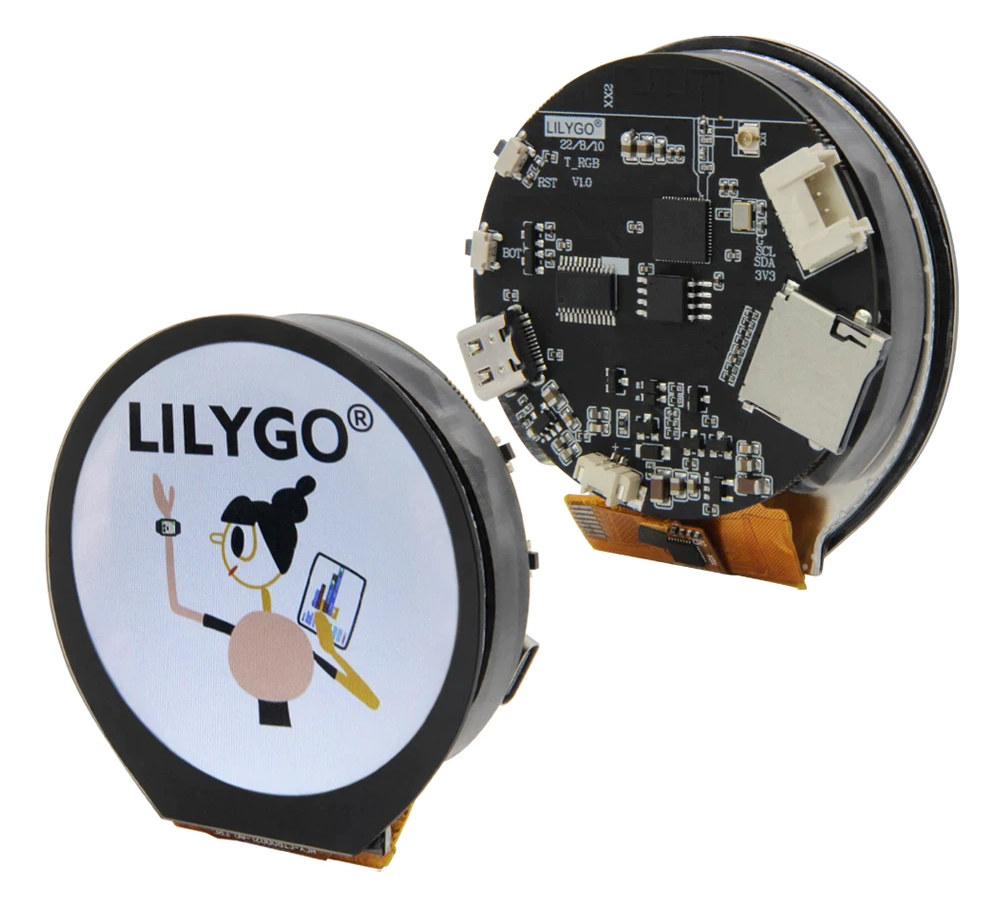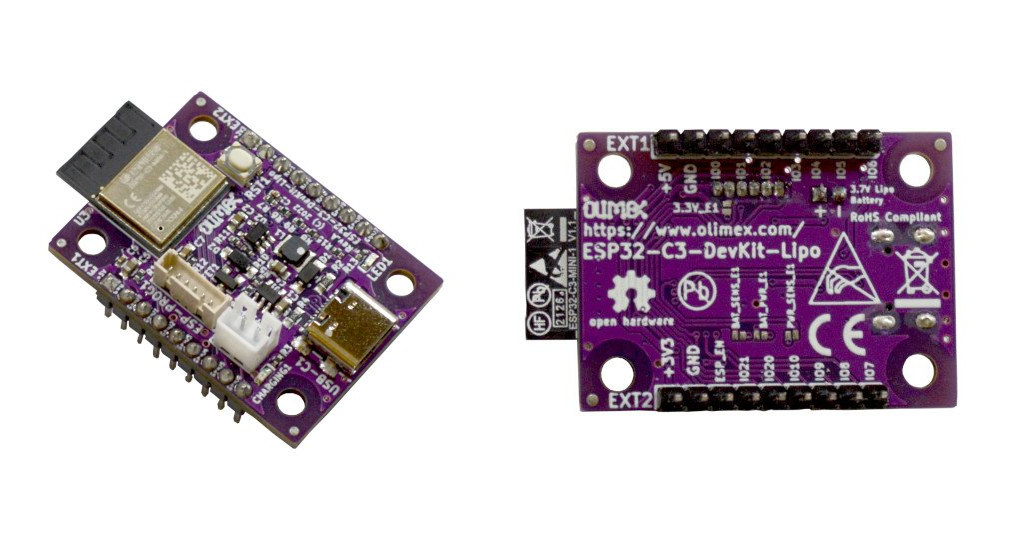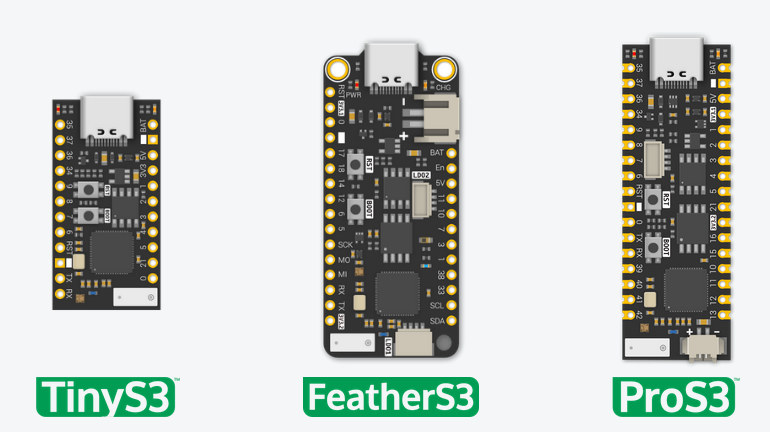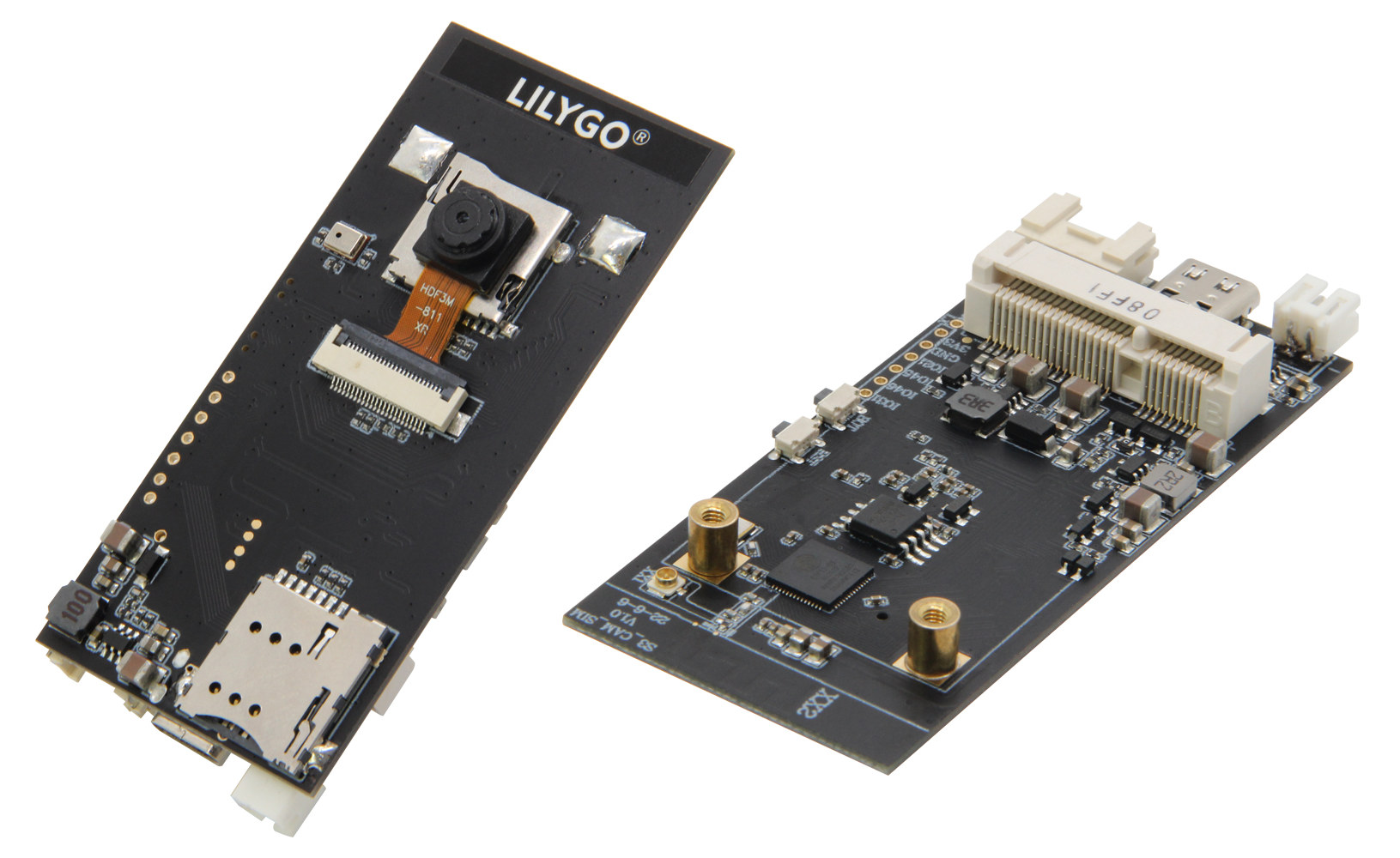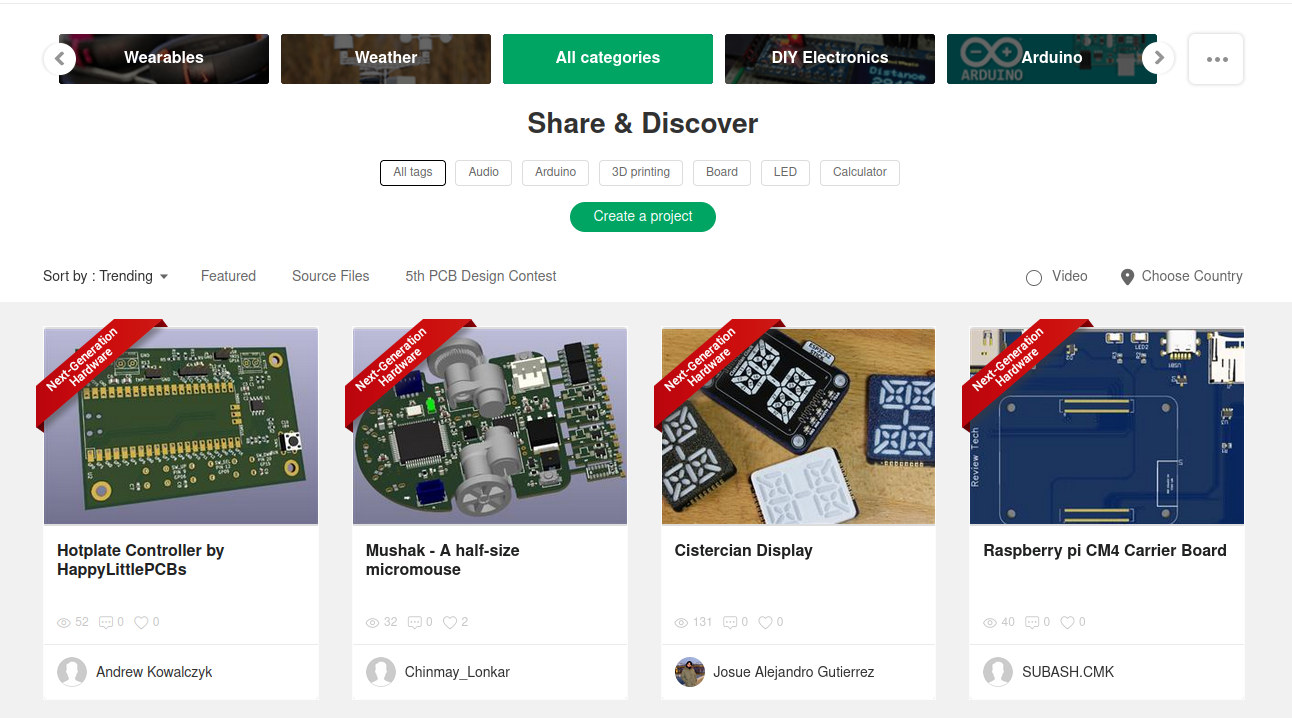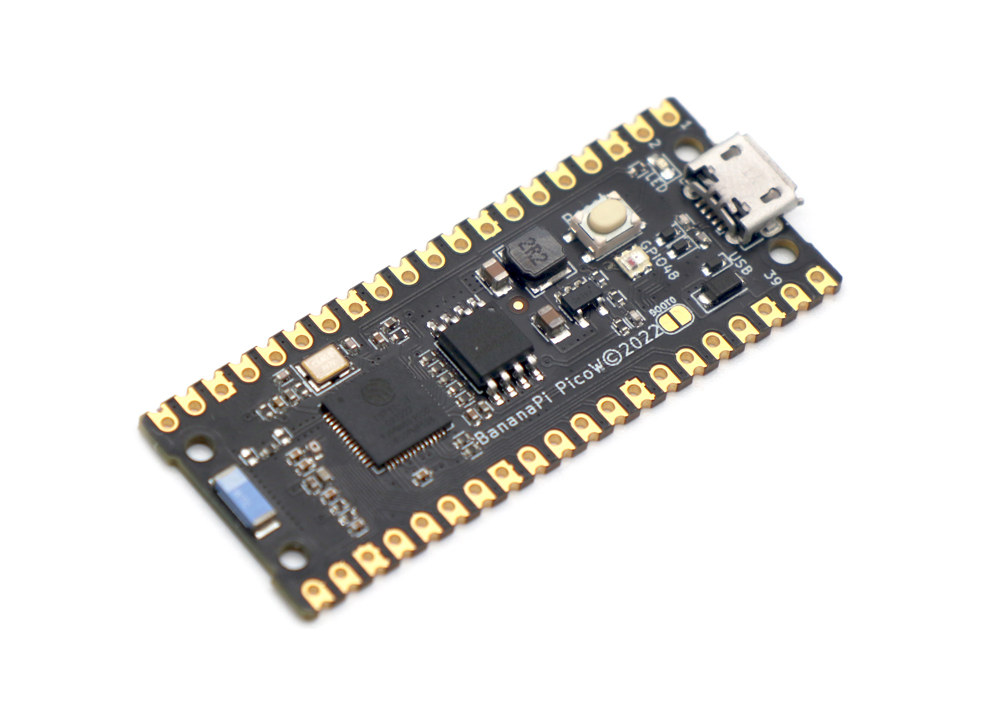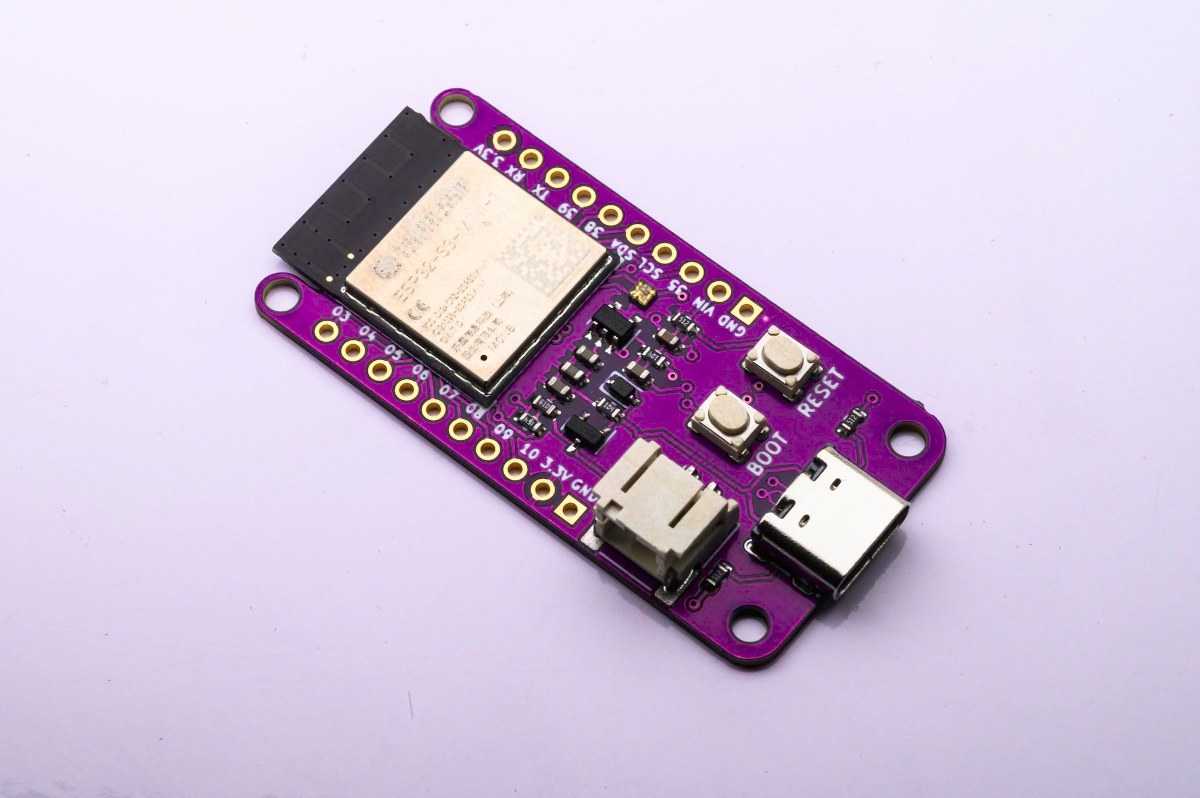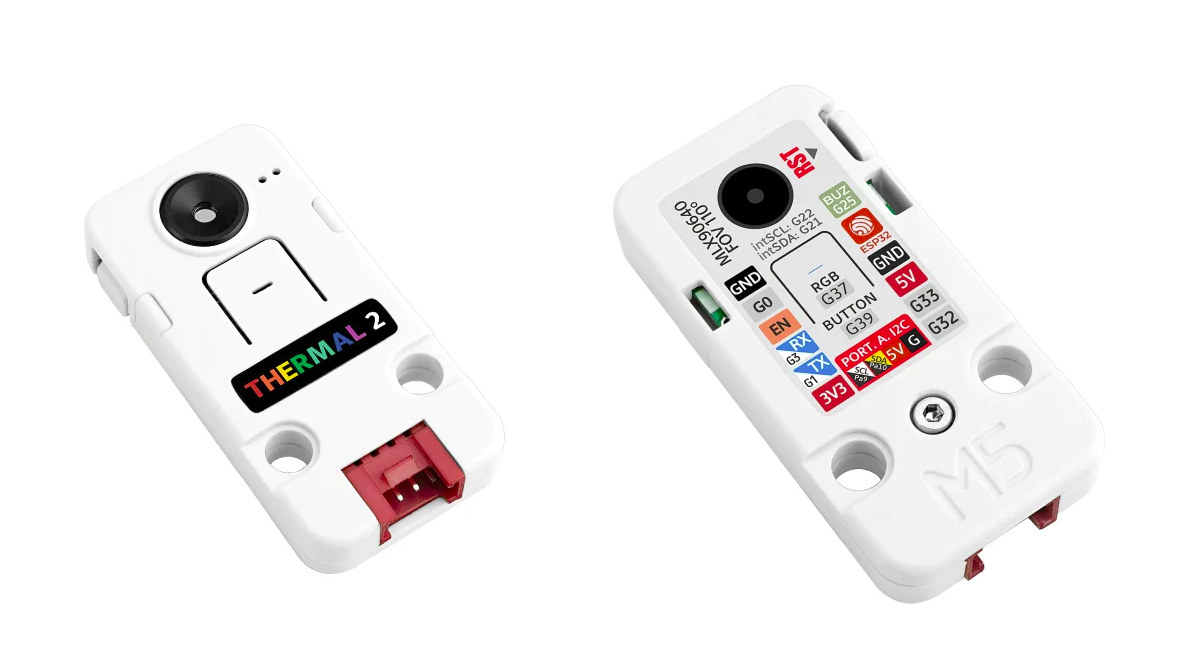LILYGO T-RGB is a wireless 2.1-inch round color touchscreen display based on ESP32-S3R8 dual-core microcontroller with WiFi 4 and Bluetooth 5.0 connectivity, 8MB PSRAM, and 16MB flash storage. The device also includes a microSD card socket for data storage and a Grove I2C connector for expansion and supports LiPo battery power. The company also says it can be charged through USB, so the board must include a battery charging circuit contrary to some other boards from LILYGO. LILYGO T-RGB specifications: SoC – Espressif ESP32-S3R8 dual-core Tensilica LX7 microcontroller up to 240 MHz with vector instructions for AI acceleration, 8MB PSRAM, WiFi 4 and Bluetooth 5.0 LE + Mesh connectivity Storage – 16MB SPI flash, MicroSD card socket Display – 2.1-inch round 18-bit RGB color IPS TFT display with 480×480 resolution (ST7701S SPI controller), touchscreen panel USB – USB Type-C port for power and programming Expansion – Grove I2C connector Misc […]
Olimex ESP32-C3-DevKit-Lipo is a tiny RISC-V board with WiFi 4, Bluetooth 5.0, and a LiPo battery charger
Olimex has just launched the ESP32-C3-DevKit-Lipo board based on ESP32-C3 RISC-V wireless microcontroller offering WiFI 4 and Bluetooth 5.0 connectivity, some I/Os, as well as USB and JTAG. As its name implies, the board can be powered by a LiPo battery and charged through a USB Type-C port. It offers up to 15 GPIO for expansion and comes with an ICSP connector in case you need to reflash or debug the bootloader through a JTAG interface. ESP32-C3-DevKit-Lipo specifications: Wireless module – Espressif Systems ESP32-C3-MINI-1-N4 module with: ESP32-C3 (ESP32-C3FN4) 32-bit RISC-V single-core processor up to 160 MHz with 4 MB embedded flash, 384 KB ROM, 400 KB SRAM (16 KB for cache), 8 KB SRAM in RTC Connectivity – 2.4 GHz 802.11b/g/n Wi-Fi 4 1T1R up to 150 Mbps & Bluetooth LE 5.0 with PCB antenna USB – 1x USB Type-C port for programming and JTAG debugging Expansion – 2x 9-pin […]
Unexpected Maker TinyS3, FeatherS3 and ProS3 boards feature ESP32-S3 dual-core wireless MCU
Seon Rozenblum, better known as Unexpected Maker, has launched upgrades to its ESP32-S2 boards such as the TinyS2 with ESP32-S3 variants, namely TinyS3, FeatherS3, and ProS3 boards. The new boards share the same form factors as the TinyS2, FeatherS2, and ProS2, but they get a more powerful dual-core microcontroller with AI instructions and 512kB SRAM. The microcontroller also adds Bluetooth 5.0 Low Energy (BLE) connectivity with Bluetooth Mesh support, instead of just WiFi 4 connectivity found in the earlier boards. TinyS3, FeatherS3, and ProS3 boards share the following features: SoC – Espressif Systems’ ESP32-S3 with Dual-core 32bit Xtensa LX7 microcontroller up to 240MHz RISC-V ULP Co-processor 512KB SRAM 2.4GHz Wifi 4 (802.11b/g/n) Bluetooth 5.0 BLE + Mesh Memory – 8MB QSPI PSRAM Flash – 8MB to 16MB depending on the model. USB – 1x USB Type-C connector with reverse back-feed protection for power and programming Antenna – 3D high gain […]
LiLyGo T-SIMCAM ESP32-S3 camera development board supports optional 4G LTE connectivity
ESP32-S3 has been in the news recently and we just wrote about the Bee S3 and BPI-PicoW-S3 boards yesterday, but there’s more, and LilyGo T-SIMCAM ESP32-S3 is another interesting ESP32-S3 board with a 2MP camera as well as support for an optional 4G LTE module. The board can make use of the AI capabilities from the ESP32-S3 microcontroller through the built-in camera and microphone and offers two options for power with 5V through a USB Type-C port, as well as a 2-pin JST connector for connecting a battery. T-SIMCAM ESP32-S3 CAM board specifications: Wireless MCU – ESP32-S3R8 dual-core Xtensa LX7 microcontroller with WiFi 4 and Bluetooth 5.0 LE and Mesh connectivity with 8MB PSRAM Storage – 16MB QSPI flash, MicroSD card socket Camera – 2MP OV2640 camera with 1622×1200 resolution Audio – I2S digital microphone Connectivity – Optional NB-IoT, 2G GSM, or 3G/4G LTE module via mPCIe socket and SIM […]
PCBWay – A community-focused PCB manufacturer (Sponsored)
There are many PCB manufacturers in China, but PCBWay has been around for over a decade providing PCB prototype and manufacturing services, and is one of the companies that care the most about the community with project sharing and various community events organized over the years. If you use PCBWay services, you will join the more than 70,000 customers who already used their services, and the company claims an over 99% on-time delivery rate thanks in part to having factories in Shenzhen that work in three shifts per day. In order to better serve its customer around the world, the PCB manufacturer also has offices in Hong Kong, as well as Paris, for European customers. PCBWay services include PCB prototyping and PCBA assembly services for small volume production, and the company highlights its SMT expertise and capabilities with high-speed Pick-and-Place machines that can place up to 28000 components per hour […]
$5.5 Banana Pi BPI-PicoW-S3 ESP32-S3 board follows Raspberry Pi Pico W form factor
Banana Pi’s BPI-PicoW-S3 is a development board following the Raspberry Pi Pico W form factor, but based on Espressif System ESP32-S3 dual-core microcontroller offering both WiFi 4 and Bluetooth LE connectivity. The Raspberry Pi SBCs have inspired many designs, but the Raspberry Pi Pico MCU boards less so. So far, I had only seen the WeAct RP2040 board with the same layout except for a USB Type-C port and a 16MB flash. But the Banana Pi BPI-PicoW-S3 provides a direct alternative to the Raspberry Pi Pico W with a more powerful microcontroller, vector instructions for AI acceleration, BLE, and about the same price at $5.5 plus shipping. Let’s see how the BPI-PicoW-S3 specifications compare to the ones of the Raspberry Pi Pico W in the table below. While the power signal (5V, 3.3V, GND) and GPIO numbers are the same on both boards, there are a few variations here and […]
Bee S3 ultra-low-power ESP32-S3 board can last several years on a LiPo battery
Smart Bee Designs’ Bee S3 is an ultra-low-power development board based on Espressif ESP32-S3 WiFi & Bluetooth microcontroller that consumes less than 20 uA in deep sleep mode allowing the board to theoretically last over 5 years under specific conditions. The board provides WiFi 4 and Bluetooth 5 LE connectivity, features a battery voltage monitoring circuitry to check the battery charge level, a USB Type-C port for power and programming, plus 20 through holes for extensions such as connecting sensors, and so on. Bee S3 specifications: Wireless module – Espressif Systems ESP32-S3-MINI-1 module (PDF datasheet) with ESP32-S3 dual-core Xtensa LX7 processor with WiFi 4 and Bluetooth 5.0 connectivity, 4MB or 8MB QSPI flash, PCB antenna USB – 1x USB Type-C port for power and programming Expansion – 2x 10-pin headers with up to 15x GPIO, 8x ADC, touch support, I2C, SPI, UART, 5V In/out, 3.3V out, and GND Misc – […]
M5Stack Thermal Camera 2 Unit combines ESP32 WiSoC with MLX90640 thermal camera
We’ve already seen the ESP32 used with a thermal camera (Flir Lepton 3.5) in the tCam-Mini IR board, but M5Stack Thermal Camera 2 Unit offers a more affordable ESP32 thermal camera solution thanks to the MLX90640 IR array thermal camera with a 32×24 resolution. Based on the ESP32-PICO-D4 system-in-package (SiP) with a dual-core microcontroller offering WiFi and Bluetooth connectivity, the camera module offers a field of view of 110°x75°, and a temperature measurement range of -40°C to 300°C. M5Stack Thermal Camera 2 Unit specifications: SiP – ESP32-PICO-D4 system-in-package with ESP32 dual-core Tensilica LX6 cores, 448 KB ROM, 520 KB SRAM, 4MB SPI flash, 2.4 GHz WiFi 4 and Bluetooth 4.2 IR camera – Melexis MLX90640 Infrared (IR) sensor with 32×24 pixels IR array, range: -40°C to 300°C with +/-1.5°C resolution, FoV: 110°x75° (See datasheet) Expansion – Grove I2C HY2.0-4P interface (“Port A”) Misc – Reset button, passive buzzer, user RGB […]


